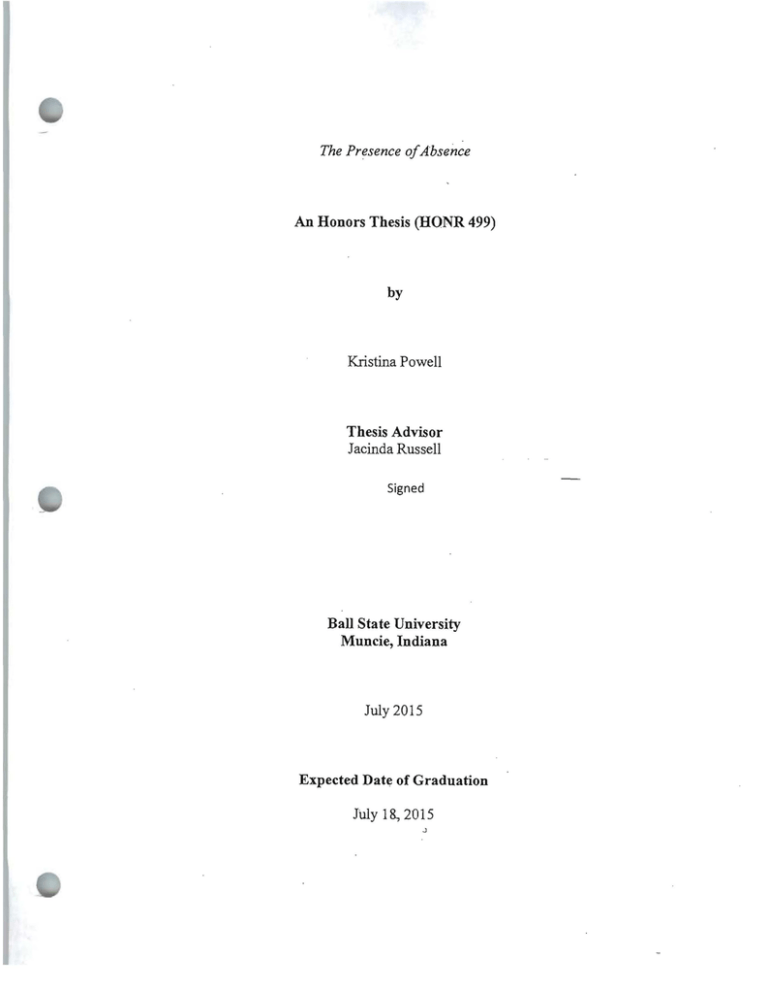Document 10999820
advertisement

The Presence ofAbsence An Honors Thesis (HONR 499) by Kristina Powell Thesis Advisor Jacinda Russell Signed Ball State University Muncie, Indiana July 2015 Expected Date of Graduation JUl.y 18., 2015 J yC'oli U I dt'/jr J ci 7ht . J­ Abstract ?o! e.9 ,. ZJ f ·PC9 The experience of a loss due to death has been portrayed in the art world in many forms and through many perspectives. Using my photographic abilities, I have given my perspective of what I experienced while mourning the loss of my mother. The inspiration to do this project was the approaching date of my birthdate in which I turned 48, the same age as my mother when she left this world. Even though it has been 17 years I still feel the pain of my mother's absence. I have symbolically represented my mother in my photographs as a void in the images, and placed texts beside them to portray my thoughts and emotions. I chose to develop the images in black and white and displayed them in white frames for uniformity. The technical inspiration for the developing of the photographs and how the images were displayed in the Atrium Gallery came from multiple artists, past and present. 2 Acknowledgements I would like to thank my thesis advisor and professor, Jacinda Russell, for her professional and critical eye during the writing process of my senior thesis. She especially has been an influence in developing my abilities in photography through out my tenure at Ball State. I want to thank my professor Mark Sawrie for his professional influences during my senior project. He has given me many perspectives on how to approach my project and without that influence I would not have presented the project in the format that it is presently in. I want to thank my fellow students and friends Amanda, Cory, Marissa, Melissa, and Niki, for their critical thoughts and inputs while I was developing my senior project during our Advanced Directions class. I want to especially thank my husband Jason for his help in developing my idea for my project. His patience and support has been especially needed during my senior project as I revisited some very tender and painful memories that influenced the outcome of my final project. 3 Author's Statement My mother died 17 years ago at the age of 48. Recently, having just turned 48 myself, I have been forced to face my own mortality. Depicting death is nothing new in the art world but sharing something this intimate is new to me. As a result, I am compelled to explore all the thoughts and emotions that I have experienced after receiving the news of her death so many years ago. We are told about the stages of grief that everyone goes through, but everyone deals with that process differently. This photographic series not only revisits how I have dealt with my grief, but it also shares how I am still living with that loss. These photographs try to capture how real and present an absence can be. To capture grief artistically means to walk a fine line between emotional melodrama that repels the viewer and a reserved stoicism with which few can relate. Therefore, I have chosen to present this theme metaphorically, to demonstrate through my images a wide array of irrational thoughts, a spectrum of feelings, and, at times, a legitimate lack of emotion that has characterized my responses over the years. By revealing my grieving process in this series I hope to draw my viewers in and compel them to reflect on their own grieving process, or to at least gain a better appreciation of someone else's loss. I tend to believe that our culture is uncomfortable with suffering in general, not just grief. We are made to think that if we are not happy then something is wrong with us. People will tell us to "cheer up," or "don't think about it so much," or, if they are less patient, "snap out of it," or "it's time to move on," which is something I am gui-lty of having said in the past. This impatience may stem from people ' s own discomfort in being around those who are in pain. But we are all tempted to ignore pain, whether it is our own or someone else's. It is always easy to point fingers at those who abuse alcohol or drugs as a means of escape, but all of us tend to 4 distract ourselves through socially acceptable " narcotics" such as food , television, social media, music, etc. We forget, or are encouraged to forget, that the pain we are trying to avoid is a necessary part of our healing. I should be the first to confess that I have done my share of avoidance over the years. Even though grief, especially over the loss of a loved one, is a particular form of suffering, our culture still has expectations as to how much and how long someone should mourn. A portion of artist Eric Gottesman's film, Sudden Flowers, I shows Ethiopian children demonstrating how they mourn with their whole bodies; they are animated and unembarrassed, unconscious, about their emotional effusion. I have to believe, as many people as there are in the world, that is the number of possible ways to grieve. Everyone does it differently. There is no right or wrong way to miss someone, to feel sadness or loss. I want to challenge my cultural expectations that add rules to how people should respond to death. This project looks at one particular way of grieving: mine. I have asked myself many questions over the seventeen years: Is it still okay to grieve after that length of time? Shouldn't the hurt be gone by now? Is it normal to still feel this way? Did I demonstrate my sadness "appropriately," or "respectably" according to my society's unwritten rules? Yes, I have been self-conscious at many times as to whether I should still be feeling a particular way or not. That is my culture's influence. And when others are forced to ask these same questions, it continues to show just how wrrealistic our culture can be in determining right and wrong when it comes to mourning. One expectation that I have unconsciously "rebelled" against is the five stages of grief? Psychologists have determined this to be the natural process for emotional healing, and though I I Yabatlda Le Li). Perfonned by Sudden Flowers, Ethiopia, 2006, Film. '-1 Kubler-Ros s, Elizabeth. On Death and Dying. New York, New York: Macmillan Company, 1969. 260. 5 do not disagree with these findings, I have discovered that it did not necessarily work that way for me. Many times I thought I had moved on from a particular stage, only to have it hit me again later, sometimes years later. I often felt that I was oscillating back and forth through the stages, in part, because the emotional wounds were never completely healed the first time through. Knowing there is a "formula" may be comforting, but when it becomes protocol, or cemented, it can increase those unrealistic cultural and self-imposed expectations. One thing I know for sure is that grief and death are something everyone encounters if they live long enough, and I want to provide my journey as a particular perspective; to show that grief may not be consistent or rational, or follow any rules. I have also come to realize that grief is something that cannot neatly (or even messily) be put into words. How do I explain the inexplicable? Or convey the importance and necessity of Andy Warhol, 1986, Robert Mapplethorpe dealing with pain when I also want to run from The Presence ofAbsence, 2015, Kristina Powell it? Or, show that it is not only a vital part of healing but also a vital part of being human? How do I challenge preconceived rules, timelines, and emotions a person is supposed to follow? That is what The Presence ofAbsence is doing. The technical inspiration for this project has come primarily from two photographers who are known for their portraiture, and two filmmakers with a unique approach to black and white imagery. During my study in photography, I have tried at one time or another to incorporate these artists' techniques into my own work. 6 In photography, I became enamored with Robert Mapplethorpe's black and white portraits of famous individuals such as Andy Warhol,3 Patti Smith, and Debbie Harry. He created silver gelatin prints using high contrast filters, which made the whites incredibly white and the blacks so encompassing, that his subjects almost disappear into the darkness. In the series, The Presence of Lucy Lu, 1991. Anne Liebowitz Absence,4 I use a similar technique to create voids in the images to limit how much information my viewers are allowed to see, such as a boy's face and hands illuminated by a computer monitor while the rest is lost in the dark. Fashion photographer Annie Liebowitz,S whose celebrity black and The Presence ofAbsence. 2015, Kristina Powell white portraits have become household names, inspired me to use a minimalist approach. Her portraits offer simple poses and design, leaving nothing to distract from her subjects, which is what we see in the image of Lucy Lu. My image of a purse lying alone on a Alfred Hitchcock Presents. 1955 The Presence ofAbsence, 2015, Kristina Powell table tries to capture the same simplicity that Liebowitz accomplishes in her portraits. I have also become fascinated with cinema's use of lighting techniques. Alfred Hitchcock6 was the first filmmaker to utilize deep shadows to create mystery and to elicit fear within his viewers. I use a single light source in every image of the series for the same shadow effect, not to create fear but to emphasize the absence or the void around the subject in the Robert. "Andy Warhol." The R,)bert Mappkthorpe f;oulldati,m Januarv f. 19X!-\. Acc~ss~d /\pril27, 2015. hUp:llwww.mapplethorpe.orgj. 4 Powell. Kristin3. "The Presence of Ahsence " Lcctur~. Senior bhihition. Muncie. IN. April 13.2015. 5 "Lucy Lu." Bio. Biographv Annie I.eibovill... LlOuar> I. 21l I ~. Accessed April 27. 20 15. http://www.hiographv.com/pl.nrlc!annic-Icibovitz­ 9542372#later-work. 6 "Alfred Hitchcock." IMDh. January I. I<,)l)() Accessed :\pril ~7. 2(l1~. hllp//Ww\\.illldncnlll/namcinm000003J!bio 3 Mapplethorpc, 7 image. For example, a single light emanating from a sliding glass door reveals a young man on an empty snow-covered deck, alone, in the dark. Finally, Rod Serling, creator and director of the television series The Twilight Zone,7 also used shadows for mystery, but he preferred to film in darkness with a single light source, or in low light to conjure a more dreamlike or surreal atmosphere. My image of a single car in an empty parking garage succeeds in capturing the quality Mr. Den/on on Doomsday. 1959, Twilight Zone The Presence ofAbsence. 2015, Kristina Powell of a dreamlike atmosphere. To create The Presence ofAbsence, I used a hybrid version of black and white 35mm and digital imaging. My camera is a Canon AE-l, the same model that my mother used to photograph family events while I was growing up. Although my mother shot in color I have chosen to work in black and white, in part, because black and white connotes memories and past events. Also, black and white produces strong and beautiful contrasts between light and dark that color cannot do. The dark areas, or voids, in my photographs limit how much information I want to reveal to the viewers. This technique incorporates an absence, and this absence is the only representation of my mother throughout my work. When a viewer looks at my series the idea of grief would not necessarily come to their minds. The subtlety of the metaphor of absence requires that my images rely heavily on text, or narratives, to orient the viewer to the theme of the series. I am creating a narrative as if I am holding a conversation with the viewer, telling the viewer about my experience of my grief. There are images that tell a story of when I first received the news of my mother's death, then a pause with images that has no text at all. Next, there are narratives with shared memories and another pause, giving time for thought, similar to the flow of a conversation between two people. 8 I thought a lot about how I was going to display the frames for my senior exhibition, and I was content that all my photographs were going to be the same size, 17" x 22", matted and framed, and hung on the wall in a linear format. But, I had an interesting conversation one day with a visiting artist, printer and bookmaker, Joseph Lappie, who gave me a great idea of where and how to place my narratives and to change the sizes of my photographs for a better impact. When it came time for my show, I still hung the frames on the wall in a linear sequence but the size differences and the placement of the narratives created a sense of interruption in the sequence. In other words, this interruption solidifies my earlier assertion of how the experience of grief is not a uniform process; the lack of uniformity of the size and placement of the images was meant to convey this important aspect. The frames I used are recycled frames I purchased second hand. I painted them white for uniformity but each frame still has its o\\n (! istinct style just as each of these memories was an experience of its own. I sand papered SOllle ',: f the edges of the frames, roughing the paint up for a wear-and-tear look. This is to convey that 1 have carried these memories around with me for seventeen years . I chose to end my series with a picture of myself inspecting the present;Jt iull of my photographs in my senior showcase. I did not put a narrative with this for I beJi-..:\'l.' 1bat it speaks for itself. I am wearing a mortarboard and tassel upon my head and holding a t'l'admtion gown over my right arm and I am looking at my photographs hanging on the Atrium G;dk ry wall. The cap and gown are black, representing the Bachelors Degree I will be earning U' ll ll !' I'aduation but it is also another representation of the void, which is consistent throughout my SCl'i l.' s. The image is brighter than the rest of my photographs and the void is much smaller showi that I still feel the absence of my mother. This is especially true when such a b occurring in my life, even though I have "technically" moved on and accompJ ' 9 lC! II I v viewers ' ~ \c'nt 1', is great things. My biggest hope for this series is that I make a connection with my vie \\ "IOS, That this series will reach out and give my viewers pause, and to reflect on what they m \ have experienced through their own grieving process or gain respect and compassiol .. 11" someone they know who has gone or going through it. As I mentioned earlier grief doesll't occur exactly the same way for everyone and it doesn't follow set guidelines in an orderly f l ' iJi" Il, It is perfectly normal that the pain still hurts, but the occurrence of it does get fU11h ,o ll1d further apart as we move on in our lifeo That is part of being human and that is okay, 10 Image Inventory The Presence ofAbsence, 2015 1. Waiting Archival Inkjet Print 8" x10" 2015 2. Alone Archival Inkjet Print 17"x22" 2015 3. Emotional Archival Inkjet Print 17"x22" 2015 4. Me Archival Inkjet Print 29" x 23" 11 5. Shadow Archival Inkjet Print 17" x 22" 2015 6. Closet/Purse Archival Inkjet Print 11" x 14" 2015 7. Mother's Hands Archival Inkjet Print 22" x 17" 2015 "".~ , I ; 8. Graduation Archival Inkjet Print 14"x11.5" 2015 12 Image Inventory The Presence ofAbsence, Senior Exhibition, 2015 Ball State University, Muncie, Indiana II • II I I, ­ ,• -­ , ... 1" : . • • . ' II - I•• 13 I 'I




